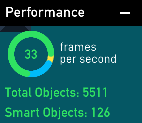The majority of these blocks are simply ground blocks, my main hypothesis as of now is that background blocks have no collision and therefore no lag, so my current project is to replace all blocks not touched by players with background blocks. Is this a valid solution? @grazer
That would explain a lot, I noticed a lot of the game world blocks turned into backgrounds.
Wait, but background objects have behaviors, and if they have nothing in their behavior window it shouldn’t matter what layer you’re in, right?
They still have some blocks, remember our uh, auto grass
They still have to test for collisions for all other physics objects if I’m not mistaken.
Oh right, I used raycasts for that, I think those cause lag, but it only triggers ‘once’
Shifting objects into the background will remove their collisions, but you can do the same thing by unchecking “movable”, “is solid”, and “enable collisions” in the physics settings. There really isn’t a need to move them into the background.
You are definitely correct that objects with no physics will have a much smaller performance impact on the game.
If you have Raycasts (or any other logic) in your ground objects, this could be preventing some optimizations. So here are some details of of how things work internally that you normally don’t need to worry about, but understanding might help with making your game faster:
Smart Objects:
Objects that have behaviors (even just one) are called “smart objects”. They have to be evaluated every frame. This process is very fast, but if you have many tens of thousands of “smart objects” you might want to consider if there is an alternate approach.
Merging
Objects that meet this criteria:
- No behaviors
- Rectangle collision shape
- Not movable
- Are the same type
- Are touching
will get merged together when the game starts, so that if you have a group of objects like this:
+-+-+-+-+-+
| | | | | |
+-+-+-+-+-+
| | | | | |
+-+-+-+-+-+
When the game starts, they will be merged into a single shape in the physics engine like this:
+-+-+-+-+-+
| |
| |
+-+-+-+-+-+
This process makes the collision detection much faster (e.g., 1 check instead of 10 checks in that example above), and also makes the ground smoother (fewer vertices to potentially snag on)
If you have large levels with many objects, having these points in mind will help keep things running fast. Let me know if I didn’t explain anything clearly, or if you have questions about any of it.
That’s a lot of good information to keep in mind, I do have one question.
Are they considered smart objects if the behaviors aren’t running?
@meburningslime, we can just get rid of the behaviors in the ground object and do it the old-fashioned way by not having the autograss thing. It may take a long time to change but it should be faster while the game is running.
Yes, adding any behaviors will make them smart objects. There is no way to predict whether the behaviors should be running or not without running them, since they can start back up at any time.
More optimizations for merging have been discussed, such as still allowing merging unless a certain subset of behaviors are used (e.g. destroy, position, rotation, etc) that modify the physics. This would enable blocks with auto-tiling systems in them to still be merged. They would still be smart objects, however, and get evaluated every frame.
Also, the number of Smart Objects is listed in the performance metrics panel.
Ok, so I deleted the behavior in the main ground block, the smart object count went down by 900. 
Not sure if this is a bug or something but I had to refresh to get the smart object number to change.
Did this have an impact on performance, and could you tell if the main ground blocks are being merged now?
Merged ground blocks will also usually improve the collision calculations so that moving objects can slide more smoothly without snagging.
I think it did, I’m not sure because I didn’t have that much of a lag issue, to begin with, I think the lag mainly happened on smaller devices like Ipads and Chromebooks.
This is intentional. Since it is just an optimization and doesn’t alter the game’s behavior, the engine does not bother trying to “dumb down” previously “smart” objects.
The issue is that we made a simple auto-generation terrain, so all blocks test with raycasts for ground.
I assumed this, I did not know that unsolid blocks are also good for this. One question, how would I “merge?” Just make a bigger block?
I was able to get rid of like 900 of the smart objects.

I discussed how the merging works here: Massive quantity level lag - #14 by grazer
You don’t have to do anything - it happens automatically when the level starts wherever blocks are merge-able (not movable, no behaviors, rectangle collisions, touching, same type)
But how do I merge? What do I do to merge?
I believe it’s automatic, as long as the objects follow the rules.